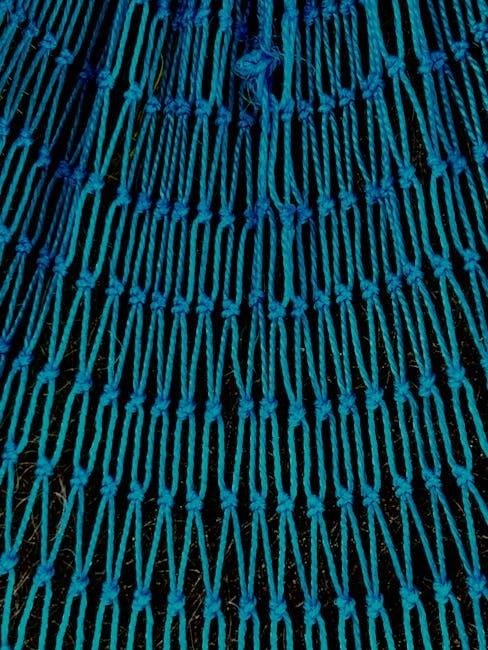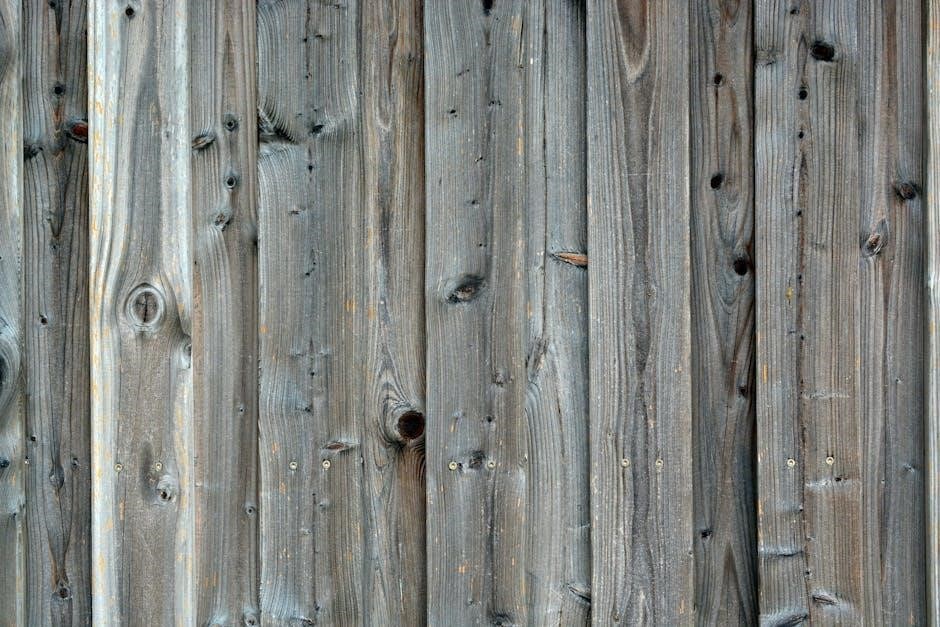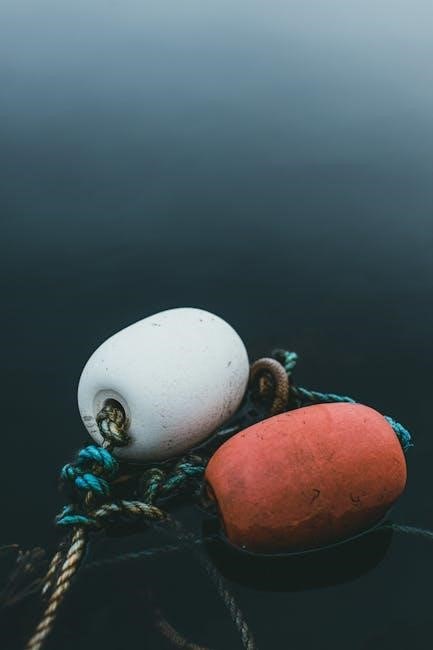Paracord knots are essential for outdoor enthusiasts, offering versatile solutions for camping, survival, and crafting. They provide reliable fastening and tensioning, crucial in various applications.
What Are Paracord Knots?
Paracord knots are specialized tying techniques used to secure, fasten, or create loops with paracord, a durable and versatile cord. These knots, such as the Matthew Walker and Solomon Bar, are designed for strength and reliability. They are widely used in survival, camping, and crafting projects like bracelets or lanyards. Paracord knots are categorized into hitches, loops, and stoppers, each serving specific purposes. Their simplicity and effectiveness make them indispensable for outdoor enthusiasts and DIY enthusiasts alike. With proper technique, these knots ensure secure and adjustable connections, making them a cornerstone of paracord projects. Their applications range from functional to decorative, offering endless creative possibilities.
Importance of Learning Paracord Knots
Learning paracord knots is vital for enhancing outdoor skills and ensuring preparedness in survival situations. These knots provide reliable fastening solutions, essential for securing gear, creating shelters, and even crafting tools. Mastery of techniques like the Larks Head and Trucker’s Hitch allows for efficient use of paracord, minimizing waste and maximizing functionality. Additionally, understanding these knots opens up creative possibilities for DIY projects, such as bracelets and accessories. The ability to tie secure knots can be a lifesaver in emergencies, making it a valuable skill for outdoor enthusiasts and adventurers. Regular practice ensures proficiency, enabling quick and effective applications in various scenarios. This knowledge enhances self-reliance and confidence in the field.

Materials and Tools Needed
Paracord knots require quality paracord, scissors, a lighter, and a sturdy tool for tightening. These materials ensure durability and proper knot formation for any project.
Understanding Paracord Types
Paracord is categorized into types based on strength and durability. Type I is lightweight, suitable for crafts, while Type III (550 cord) is the most common, with a 550-pound tensile strength. Type IV offers even greater durability. Each type varies in thickness and flexibility, making them ideal for different applications. When selecting paracord, consider the project’s requirements to ensure the right balance of strength and manageability. Proper understanding of paracord types enhances the effectiveness of knots and ensures reliable performance in various situations, from outdoor gear to decorative items.
Essential Tools for Tying Knots
Having the right tools is crucial for tying paracord knots effectively. A sharp utility knife or scissors is needed for cutting paracord cleanly. A lighter or torch helps in melting the ends to prevent fraying. A tape measure ensures accurate measurements for consistent results. Optional tools include a cord clamp for holding the paracord steady and a wax for lubricating knots. These tools enhance precision and efficiency, making the knot-tying process smoother and more professional. Proper preparation and the use of these tools contribute to stronger, more durable knots in various paracord projects.
Key Knots for Paracord Projects
Mastering essential knots like the Solomon Bar, Larks Head, and Matthew Walker is vital for creating sturdy and functional paracord designs, enhancing both utility and style effectively.
Solomon Bar Knot
The Solomon Bar Knot, also known as the Knighthood Knot, is a popular choice for paracord projects. It creates a textured, woven pattern that adds both strength and visual appeal to bracelets, straps, and other applications. This knot is particularly favored for its durability and aesthetic charm, making it a staple in many paracord designs. To tie the Solomon Bar, begin by creating a loop and then weave the paracord through it, following a series of under and over passes. Tightening each pass ensures a secure and even structure. It’s a versatile knot that works well for various projects, from functional accessories to decorative items.
Larks Head Knot
The Larks Head Knot is a foundational knot in paracord projects, often used to create a loop or attach the cord to an object. It is simple to learn and forms the basis for more complex knots. This knot is essential for starting many paracord designs, such as bracelets or keychains, as it allows for easy attachment and detachment. The Larks Head Knot is also a key step in projects like the paracord bracelet, where it helps secure the cord to itself or another object. Its versatility and ease of use make it a favorite among both beginners and experienced crafters, as highlighted in many paracord PDF guides.
Matthew Walker Knot
The Matthew Walker Knot is a popular choice for paracord projects, known for its decorative and functional appeal. It creates a sleek, woven pattern that adds both style and strength to bracelets, lanyards, and other accessories; This knot is particularly favored for its symmetry and the way it lies flat, making it comfortable to wear. Many PDF guides highlight the Matthew Walker Knot as a versatile option for various paracord applications, offering clear step-by-step instructions to master its intricate design. It is a must-learn for anyone looking to enhance their paracord creations with a touch of elegance and durability.
Truckers Hitch Knot

The Trucker’s Hitch Knot is a highly practical and versatile knot used for securing ropes to objects like posts, trees, or rails. It is known for its ease of adjustment and quick release, making it ideal for camping, securing loads, and temporary fixes. This knot is particularly useful for creating tension in paracord projects without the need for complex tools. Many PDF guides highlight the Trucker’s Hitch as a must-learn for outdoor enthusiasts, offering step-by-step tutorials to master its simple yet effective design. Its adaptability and reliability make it a favorite among both beginners and experienced users of paracord.

Step-by-Step Tutorials for Paracord Knots
Step-by-step tutorials provide clear, photographed instructions for tying paracord knots, ensuring easy learning. PDF guides include detailed diagrams and written steps for each knot, enhancing understanding.
Creating a Loop
Creating a loop is a fundamental step in tying paracord knots. PDF guides often begin with this technique, emphasizing its importance for securing ends and forming the foundation of more complex knots. The process typically involves folding the paracord in half and threading the folded end through a desired object or another loop. This method ensures a sturdy starting point, which is crucial for maintaining tension and stability in the final product. Detailed photographs and written instructions in these guides help users master the loop, making it easier to progress to advanced knots like the Solomon Bar or Matthew Walker.
Securing the Knot
Securing the knot is vital for ensuring durability and reliability in paracord projects. PDF guides highlight various methods to tighten and finalize knots, often recommending techniques like pulling the cord firmly or using tools to cinch the knot tightly. Some tutorials suggest tucking excess cord under nearby wraps or applying a dab of wax for extra grip. Properly securing the knot prevents unraveling and ensures the structure holds up under stress. Step-by-step instructions in these guides provide clear visuals and tips, making it easier for users to achieve a professional finish on their paracord creations, whether it’s a bracelet, fob, or utility item.
Tips and Tricks for Working with Paracord
Mastering paracord requires patience and practice. PDF guides offer expert advice, from choosing the right cord type to maintaining even tension for professional results;
Increasing Tension
Proper tension is crucial for secure and durable paracord projects. To increase tension, start by tightening the Larks Head Knot, ensuring a firm base. Pull the strands firmly while tying knots like the Solomon Bar to maintain even pressure. For bracelets, gently tug each strand after completing a row to eliminate slack. Use a tool or finger to press down on knots, reinforcing their grip. Regularly check and adjust tension during the process to prevent loosening. This ensures your project remains sturdy and reliable, whether for survival gear or decorative items. Always test the final product under controlled stress to confirm its integrity.
- Tighten knots systematically to avoid unevenness.
- Use tools to press knots firmly into place.
- Adjust loops and strands as needed for optimal tightness.
Finishing the Paracord Bracelet
Finishing a paracord bracelet requires precision to ensure durability and a polished appearance. Begin by tightening all knots, starting from the Larks Head base. Trim excess paracord closely to the final knot using scissors or a lighter to prevent fraying. For a clean look, melt the cut ends slightly to seal them. Tuck any stray strands under nearby knots to maintain a sleek design. Adjust the bracelet’s fit by gently pulling on the loops. Finally, inspect the bracelet for any loose ends or uneven tension. Proper finishing ensures the bracelet is both functional and visually appealing, ready for everyday wear or gifting.
- Melt ends to prevent fraying.
- Tuck stray strands for a neat finish.
- Test the fit before finalizing.

Resources and Further Reading
Explore detailed guides like The Complete Guide to Knots and Knot Tying.pdf and The Klutz Book of Knots.pdf for in-depth paracord knot tutorials and projects.
Recommended PDF Guides
For mastering paracord knots, essential PDF guides include The Complete Guide to Knots and Knot Tying.pdf (29MB) and The Klutz Book of Knots.pdf (13MB). These resources provide detailed step-by-step tutorials, photos, and instructions for various knots like the Solomon Bar and Matthew Walker. The Morrow Guide to Knots.pdf (61MB) offers extensive coverage of rope work, while The Ultimate Book of Paracord Knots.pdf focuses solely on paracord techniques. These guides are perfect for beginners and experienced crafters, offering practical tips and projects to enhance your skills in creating durable and stylish paracord items.

